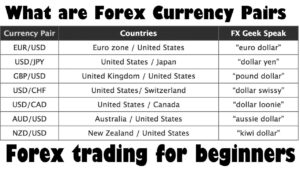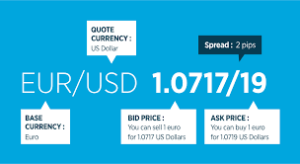Currency Pair in Forex Trading: Understanding the Basics
Currency Pairs in Forex Trading are the heartbeat of the market. This brief guide explains the fundamental concept of currency pairs, where one currency’s value is calculated against another. Discover the base and quote currencies, grasp the significance of major, minor, and exotic pairs, and unveil the bid-ask dynamics. With this knowledge, you’ll be able to navigate the intricate world of forex trading, making informed decisions to seize opportunities and manage risks effectively. Embark on your journey to trading success with a solid understanding of currency pairs as your compass.
In the exciting world of forex trading, understanding currency pairs is crucial. A currency pair is the foundation of forex trading, where you buy one currency and simultaneously sell another. This dynamic relationship between two currencies forms the backbone of all forex transactions. Let’s dive into the details with an easy-to-understand explanation and examples.
What is a Currency pairs in Forex Trading?
A currency pair is a merger of two distinct currencies, where one functions as the base currency and the other as the quote currency. The base currency is the one you’re buying or selling, and the quote currency is what you’re using to make the transaction. The value of a currency pair indicates how much of the quoted currency is needed to buy one unit of the base currency.
Example: EUR/USD
Let’s take the popular currency pair EUR/USD as an example. In this pair, the euro (EUR) is the base currency, and the US dollar (USD) is the quote currency. If the EUR/USD exchange rate is 1.1500, it means that 1 euro is equivalent to 1.15 US dollars.

Types of Currency Pairs in Forex Trading: Major, Minor, and Exotic
Currency Pairs in Forex Trading are divided into three main groups: major, minor, and exotic pairs.
Major Currency Pairs in Forex Trading
Major currency pairs in forex are the most important and commonly traded combinations of currencies. These pairs involve strong economies and widely used currencies that play a a vital role in global finance.
To put it plainly, when people talk about forex trading, they often mention major pairs like EUR/USD (Euro/US Dollar) or USD/JPY (US Dollar/Japanese Yen). These pairs are like the popular kids in school – they have the highest trading volumes and are often used as benchmarks for the forex market.
Trading major pairs is often seen as more stable because these currencies come from powerful countries with strong economies. This makes them less susceptible to sudden and extreme price changes. Traders usually find plenty of information and analysis available for major pairs, which can help them make informed decisions.
Major currency pairs in forex are the big traders’ focus on the most. They involve strong currencies from influential countries and provide the foundation of forex trading worldwide.
7 Major Currency Pairs in Forex Trading
- EUR/USD (The Euro and US Dollar)
- GBP/USD (British Pound Sterling and US Dollar)
- USD/CHF (US Dollar and Swiss Franc)
- USD/JPY (US Dollar and Japanese Yen)
- AUD/USD (Australian Dollar and US Dollar)
- NZD/USD (New Zealand Dollar and US Dollar)
- USD/CAD (US Dollar and Canadian Dollar)
Minor Currency Pairs in Forex Trading
Also known as cross currency pairs, minor pairs don’t involve the US dollar as the base or quote currency. Instead, they include other major currencies. Example: GBP/JPY, EUR/GBP.
Minor currency pairs in forex refer to pairs of currencies that are not considered the primary currencies of major economies, like the US dollar, Euro, Japanese yen, or British pound. Instead, minor pairs involve other significant currencies from smaller economies.
When trading forex, you often hear about major currency pairs like EUR/USD or USD/JPY. These involve strong economies and have high trading volumes. On the other hand, minor currency pairs involve currencies from countries with somewhat smaller economies, such as the Canadian dollar (CAD), Australian dollar (AUD), Swiss franc (CHF), and more.
While minor pairs may have slightly lower trading volumes compared to majors, they can still offer trading opportunities. Examples of minor currency pairs include AUD/CAD, EUR/CHF, and GBP/AUD. Traders interested in diversifying their forex trading beyond the most popular pairs often explore minor currency pairs to possibly capitalize on market fluctuations and trends.
Minor currency pairs are combinations of currencies from economies that are not as globally famous as major ones. However, they can still provide chances for traders to profit from the forex market’s movements.
7 Minor Currency Pairs in Forex Trading
- EUR/GBP
- EUR/JPY
- GBP/JPY
- GBP/CAD
- CHF/JPY
- EUR/AUD
- NZD/JPY
Exotic Currency Pairs in Forex Trading
Exotic pairs involve one major currency and one currency from an emerging or smaller economy. These pairs tend to have wider spreads and lower liquidity compared to major pairs. Example: USD/SGD, EUR/TRY.
An exotic currency pair in forex refers to a pairing of currencies that involves one major currency and one currency from a smaller or less common economy. Unlike major and minor currency pairs that involve well-known currencies, exotic pairs involve currencies from emerging markets or less frequently traded regions.
In simpler terms, when people trade forex, they usually talk about major pairs like EUR/USD or minor pairs like AUD/JPY. Exotic pairs, on the other hand, involve currencies from places like South Africa (ZAR), Mexico (MXN), or Turkey (TRY), combined with a major currency like the US dollar (USD).
Trading exotic pairs can be riskier because they may have wider spreads (the difference between buying and selling prices) and can be influenced by local economic and political factors. However, some traders are drawn to exotic pairs because they can show unique price movements that might lead to bigger profits if traded wisely.
AUD/NOK (Australian Dollar/Norwegian Krone)
AUD/PLN (Australian Dollar/Polish Zloty)
AUD/SEK (Australian Dollar/Swedish Krona)
AUD/SGD (Australian Dollar/Singapore Dollar)
CAD/SGD (Canadian Dollar/Singapore Dollar)
CHF/SEK (Swiss Franc/Swedish Krona)
CHF/SGD (Swiss Franc/Singapore Dollar)
EUR/CZK (Euro/Czech Republic Koruna)
EUR/HUF (Euro/Hungarian Forint)
EUR/NOK (Euro/Norwegian Krone)
EUR/PLN (Euro/Polish Zloty)
EUR/RON (Euro/Romanian Leu)
EUR/RUB (Euro/Russian Ruble)
EUR/SEK (Euro/Swedish Krona)
EUR/SGD Singapore Dollar)
EUR/TRY (Euro/Turkish Lira)
EUR/ZAR (Euro/South Africa Rand)
GBP/CZK (British Pound/Czech Republic Koruna)
GBP/HUF (British Pound/Hungarian Forint)
GBP/MXN (British Pound/Mexican Peso)
GBP/NOK (British Pound/Norwegian Krone)
GBP/PLN (British Pound/Polish Zloty)
GBP/SEK (British Pound/Swedish Krona)
GBP/SGD (British Pound/Singapore Dollar)
GBP/TRY (British Pound/Turkish Lira)
MXN/JPY (Mexican Peso/Japanese Yen)
NOK/JPY (Norwegian Krone/Japanese Yen)
SGD/JPY (Singapore Dollar/Japanese Yen)
TRY/JPY (Turkish Lira/Japanese Yen)
ZAR/JPY (South Africa Rand/Japanese Yen)
USD/CZK (US Dollar/Czech Republic Koruna)
USD/HUF (US Dollar/ Hungarian Forint)
USD/ILS (US Dollar/Israeli Shekel)
USD/MXN (US Dollar/Mexican Peso)
USD/NOK (US DollarNorwegian Krone)
USD/PLN (US Dollar/Polish Zloty)
USD/RON (US Dollar/Romanian Leu)
USD/RUB (US Dollar/Russian Ruble)
USD/SEK (US Dollar/Swedish Krona)
USD/SGD (US Dollar/Singapore Dollar)
USD/THB (US Dollar/Thai Baht)
USD/TRY (US Dollar/Turkish Lira)
USD/ZAR (US Dollar/South Africa Rand)
How to Read a Currency Pairs in Forex Trading
Currency pairs are displayed with a bid and an asking price. The bid price is what buyers are willing to pay for the base currency, and the asking price is what sellers are asking for the base currency. The difference between these prices is called the spread.

Why Understanding Currency Pairs in Forex Trading Matters?
Understanding Currency Pairs in Forex Trading is essential because it helps traders make informed decisions. By analyzing the relationship between two currencies, traders can predict potential market movements, manage risk, and identify trading opportunities.
In conclusion, currency pairs are the building blocks of forex trading. They represent the exchange rate between two currencies and play a pivotal role in determining trading outcomes. As you delve into the world of forex, mastering the dynamics of currency pairs will be your compass to navigate the exciting realm of global financial markets.





